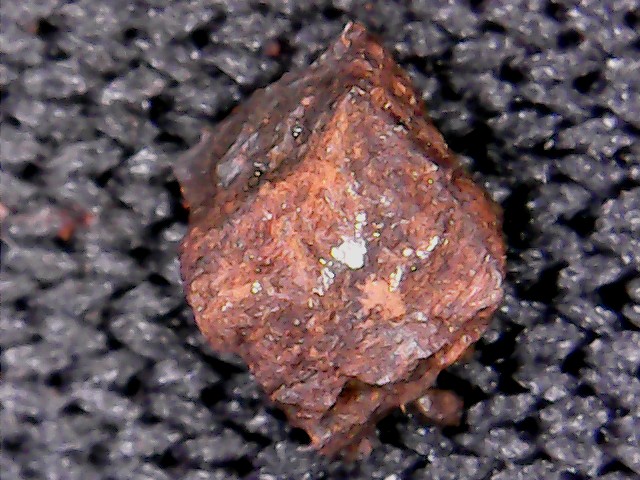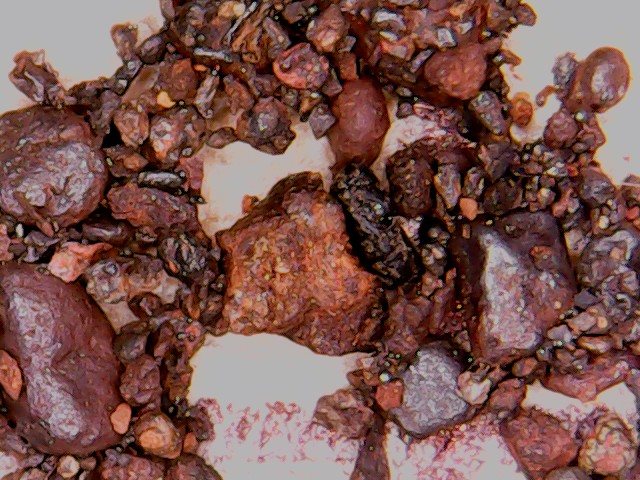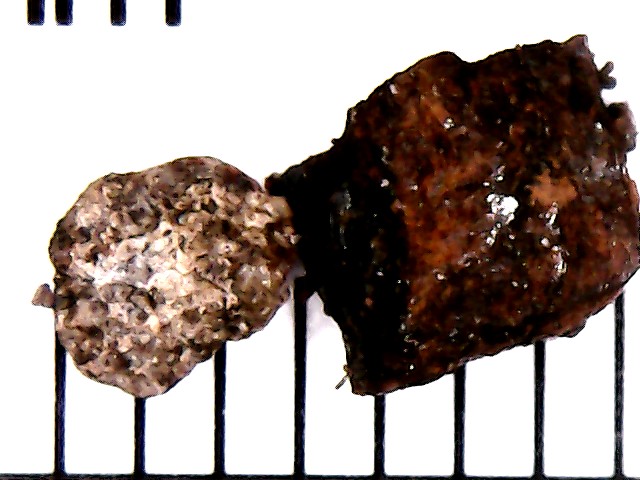Tagged: Micrometeorites
- This topic has 6 replies, 5 voices, and was last updated 2 months, 2 weeks ago by
Christopher Curtis.
-
AuthorPosts
-
2 May 2017 at 6:41 pm #573741
 DawsonParticipant
DawsonParticipantTalking to Bob Mizon at the recent Eastbourne meeting of the British Astronomical Association as he manned the Commission for Dark Skies stand, the topic of meteorites came up and the fact many have a significant metallic content. He had some on show and a magnet and sure enough the meteorites were attracted to the magnet. He explained that as an outreach activity he had asked people to bring in the sludge out of their gutters, and in the experiment mixed the sludge with water in a jam jar and wafted a magnet around in the water to attract the metallic fragments. These fragments may well have come from outer space as part of a meteorite. This idea excited me, and as one who loves to experiment I couldn’t wait to get home and rummage in my gutters.
Luckily I have some gutters at the front of the house around the porch so can easily access them with a normal step-ladder; don’t do this if you have to go very high for sludge, ask the window cleaner to get the sludge for you or rummage in someone else’s gutters after gaining their permission.
I got about 250g of stuff in total out of the gutter (I’d cleaned them pretty well about three years ago). I mixed the sludge with water and introduced the magnet; I pulled out a reasonable amount of ferromagnetic stuff (my scales don’t weight such small amount) but image below comparing the stuff to a 5p coin.
I’d already ordered a USB microscope off the internet (https://www.amazon.co.uk/COLEMETER-Handheld-Microscope-Magnifier-Endoscope/dp/B00TJYS9AG/ref=sr_1_2?ie=UTF8&qid=1493745622&sr=8-2-spons&keywords=usb+microscope&psc=1 – other retailers and options available), so once it had all dried I looked at it under the microscope.
There was a mixture of flakes of things, round pebble like things of differing colours (imaged), and what looked like conglomerate bodies with various textures and densities and numerous inclusions (imaged). The was also one silvery shiny body (imaged). The larger bits were 1.5mm to 2mm in size (imaged) – the black lines are 0.5mm apart.
So I have no idea if these are meteorite fragments or not, but it is still fascinating and has been a fun exercise. What’s more, my gutters are now spotless!
James



 2 May 2017 at 9:11 pm #578179
2 May 2017 at 9:11 pm #578179 MARC TRYPSTEENParticipant
MARC TRYPSTEENParticipantHi James,
To check if your “Gutter collection” contains possible meteorites you can try following tests:
1. Native Iron test: a magnet is attracted. This test was apparently positive.
2. Streak test: Therefore you scratch the rough side of ceramic material ( such as an old bathroom tile). If negative, this means if no streak (colored or not) is visible, it is a vote for a meteorite.
3. DMG test or Nickel test. This can be done qualitatively bij etching a part of the material with an acid solution (Nitric acid or Hydrochloric acid 1% solution in water). Afterwards you rub the stone with a solution containing 1% DMG (Dimethylglyoxime) in alcohol with 10% ammoniumhydroxide. (available at local pharmacies or on line shops). If positive means a red color is appearing. You may then go to a specified lab to do a quantitative test to determine the % Nickel.
4. Estimate the density of the rock: first weigh it on an analytical balance (ask local pharmacist), then put it in a measuring cilinder filled with water, put the rock in it and calculate the difference of the water level. Calculate density which is mass divided by volume. Depending on the type of meteorite this gives 3.5 to 4.5.
If all tests are positive go to a university lab for detailed analysis!
Success,
Kind regards,
Marc.
3 May 2017 at 6:41 am #578181 DawsonParticipant
DawsonParticipantMarc,
This is very helpful and useful to know. My fragments are too small to rub on anything I fear but at least I now know what to do if I find something bigger.
James
3 May 2017 at 8:15 am #578182 David BaseyParticipant
David BaseyParticipantHi James,
The article here may be of interest. It includes links to a number of other resources including the original professional paper.
David.
3 May 2017 at 9:00 am #578183 MARC TRYPSTEENParticipant
MARC TRYPSTEENParticipantNo problem, James, if the pieces are too small to rub you can follow an alternative procedure: pulverize some pieces to obtain approx. 1 or 2 grams of powder, put it in a glass test-tube or anything similar. Add slowly the acid solution (Nitric acid or Hydrochloric acid 1% aq. solution) to solve the powder. Then add ammonium hydroxide solution (10%) to make alcaline. In case Iron is present you will see a brown-yellowish precipitate which is mainly composed of Iron hydroxide. After filtering add some droplets of a DMG solution (1%in alcohol) to the filtrate: if meteorite material is present you will see a reddish colored precipitate.
Kind regards,
Marc.
6 October 2025 at 4:49 pm #631501 Alex PrattParticipant
Alex PrattParticipantAt the recent Comet and Meteor Sections meeting
https://britastro.org/event/comet-and-meteor-section-meeting
I referred to this paper:
and this presentation at IMC2025:
https://imc2025.imo.net/program/day3
Guido Jonker – To catch a falling star – IMC 2025_v2.pptx (170 MB download)
I’ll append an update if the session videos become available.
Alex.
7 October 2025 at 8:18 am #631503Christopher Curtis
ParticipantThe folks researching micrometeorites at Glasgow University tend to reject anything that isn’t strictly spherical. They’d expect to find three or four on an area of a football pitch, so almost everything a magnet will pick up from a gutter will NOT be a micrometeorite. If there is any metal working within 30 or so miles, most of the material will be from that, as well as weathered from local building materials.
There’s a Japanese anime (and manga) called “Ruri Rocks” (or “introduction to Mineralogy”) with an episode where the gang go looking for them. They emphasise that there might be one or two meteorites in an awful lot of other (mostly man made) things.
-
AuthorPosts
- You must be logged in to reply to this topic.
